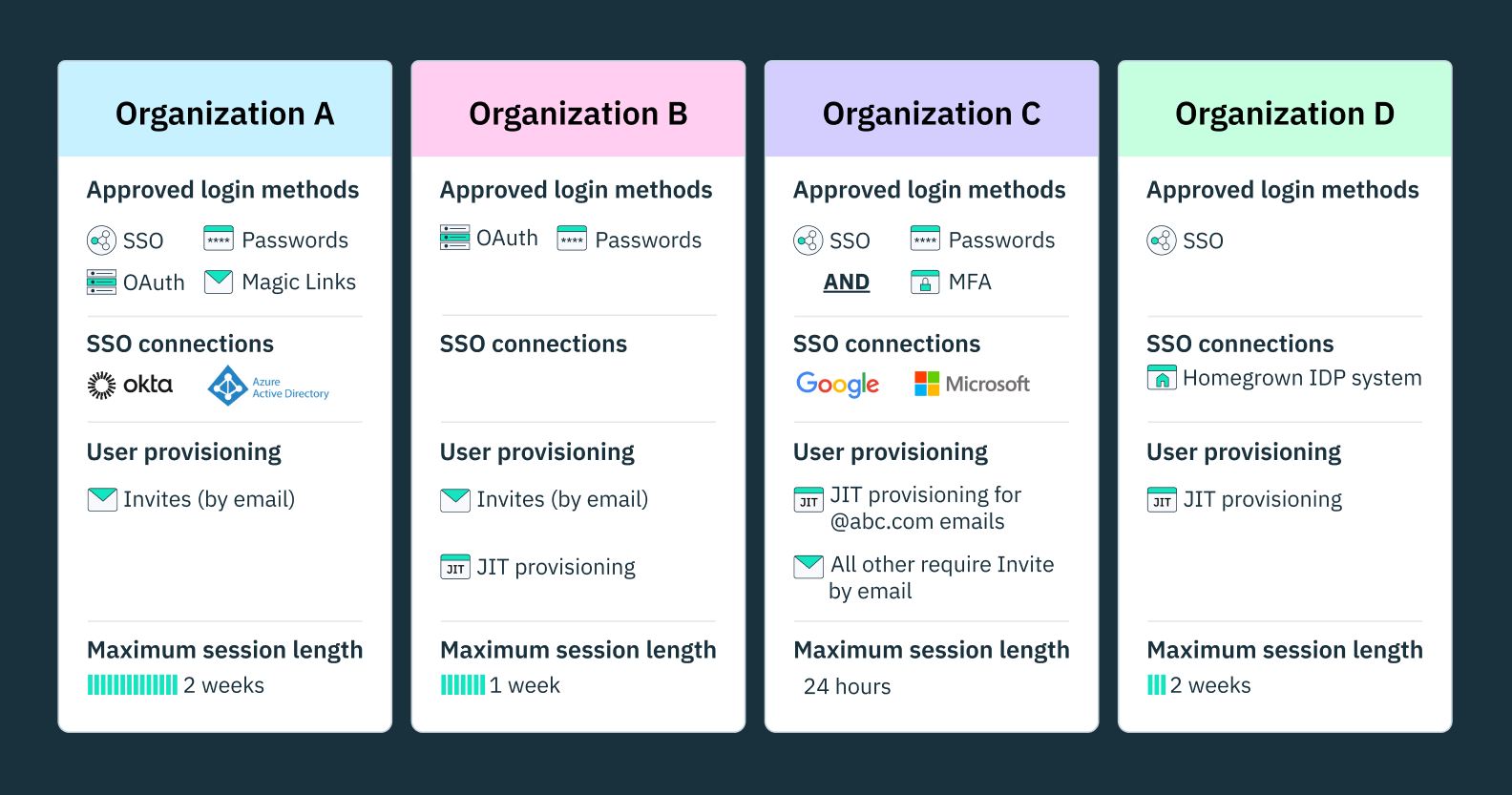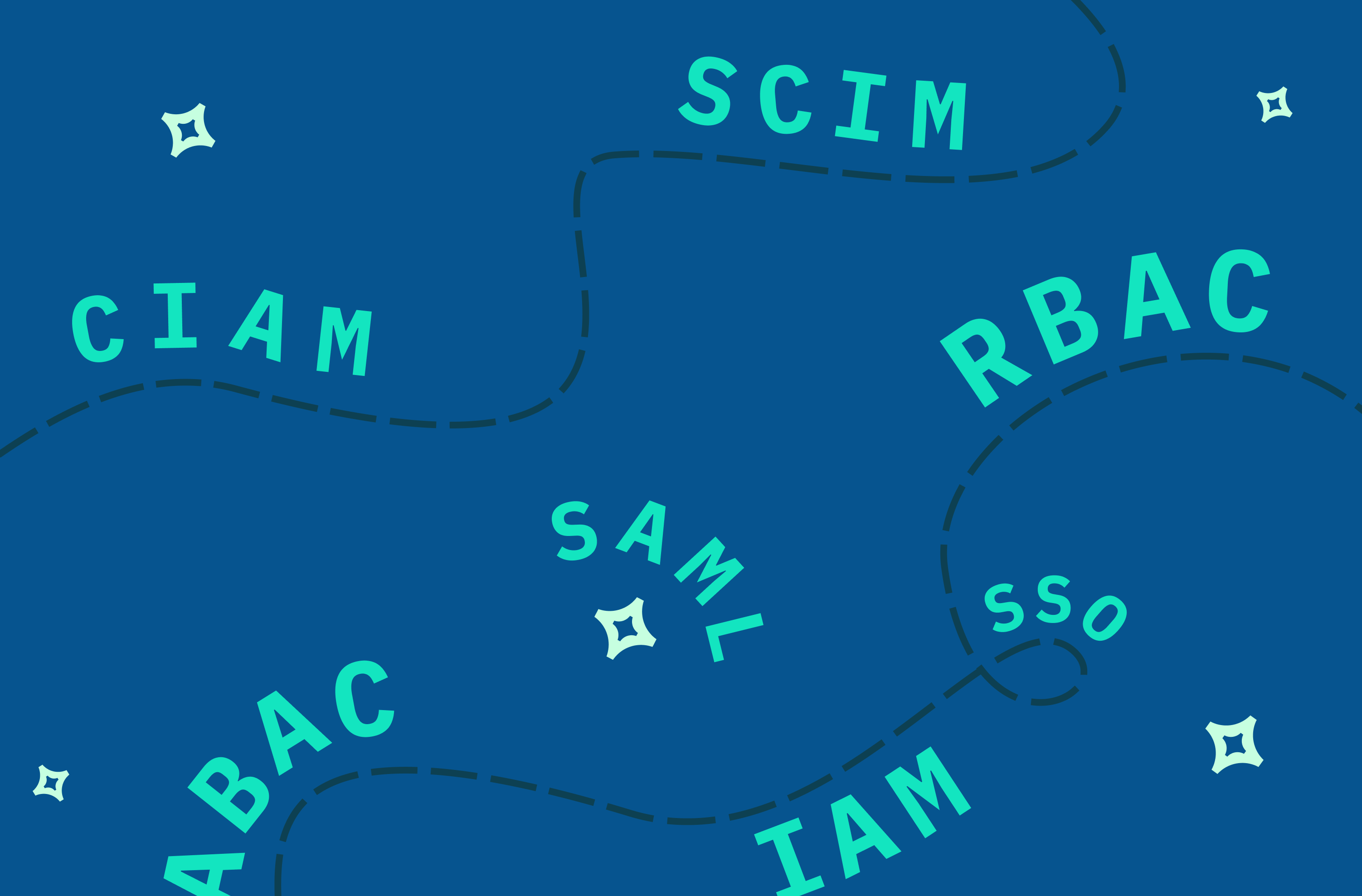Back to blog
B2B SaaS applications: A comprehensive overview
Auth & identity
Feb 23, 2024
Author: Alex Lawrence

The B2B SaaS (Business-to-Business Software as a Service) sector is a dynamic field that is reshaping the way applications operate at scale with security and organizational efficiency. These solutions are designed to meet the diverse and evolving needs of applications across various use cases and technologies. Increasingly, they have become table-stakes in an always-on, internet and cloud-native business world, where borders blur and information freely flows.
This article aims to provide developers with an in-depth understanding of the modern complexities involved in creating best-in-class B2B SaaS platforms, with a focus on the foundational technologies that enable advanced systems to flourish and gain a competitive edge, such as cloud computing services, APIs, CI/CD pipelines, DevOps strategies, multi-tenancy and scalability, and SaaS authentication.
Foundational technologies in business to business software
Cloud computing, APIs, and technologies facilitating efficient, agile development are the bedrock of the B2B SaaS industry, enabling SaaS companies to offer cloud-based software that is both scalable and flexible. To the great benefit of countless businesses, many of these solutions and practices have effectively eliminated the high upfront costs and maintenance challenges associated with traditional self-hosted software solutions. It’s a new era of lower overhead and higher potential.
Popular global cloud services providers like AWS, Azure, and Google Cloud not only supply the necessary infrastructure but also offer comprehensive suites of tools that enhance the development, deployment, and management of SaaS applications. These capabilities make cloud-based solutions an ideal choice for applications of all kinds, ensuring they have the resources to scale and adapt in a fast-paced (and constantly accelerating) digital market.
The cloud: a global app enabler
The adoption of cloud computing in the B2B SaaS industry has paved the way for more efficient application development, allowing companies to focus on their core competencies rather than IT infrastructure management – a particularly strong benefit for businesses with a global footprint.
Among other benefits to application development for B2B SaaS, cloud platforms reliably provide:
- Ready-to-use infrastructure, enabling developers to bypass the lengthy setup and configuration of physical servers, significantly speeding up the initiation of projects.
- Quick prototyping, allowing developers to test and iterate on their ideas swiftly and get products to market faster.
- Dynamic scaling that adjusts resources to meet application demands, ensuring optimal performance without manual intervention, even during unexpected surges in usage.
- Global high availability and reduced latency, offering a consistent user experience worldwide through global cloud infrastructure providers.
These high level benefits enable B2B SaaS companies to focus on innovation and delivering value rather than time-consuming infrastructure management and scalability challenges.
APIs: Building blocks of B2B SaaS solutions
APIs serve as crucial connectors in the developer’s toolkit, particularly within the B2B SaaS landscape. They enable fluid communication and integration between various software applications, including essential developer tools like GitHub and Jira. By bridging SaaS platforms with these developer-centric applications, APIs not only streamline the development workflow but also enhance collaboration and project management capabilities.
This seamless integration is key to automating workflows, from code commits and version control in GitHub to task tracking and sprint planning in Jira, making the development process more efficient and cohesive. Through APIs, developers can effectively link their SaaS solutions with a broad array of enterprise and productivity tools, transforming their ecosystem into a comprehensive operational nexus.
Interoperability and data sharing
Interoperability plays a crucial role in creating a cohesive software ecosystem, especially when facilitated through APIs, SDKs, and various protocols that developers work with. This interconnectedness enables the seamless exchange of data across a multitude of applications, enhancing the functionality and efficiency of development tools.
For instance, integrating a B2B SaaS solution with version control systems like GitHub or project management tools like Jira through APIs can streamline the development process, providing real-time insights into code changes, issue tracking, and team collaboration. This level of data sharing and interoperability allows developers to synchronize workflows, automate processes, and ultimately, optimize the development lifecycle, leading to more efficient project completion and resource allocation.
The pivotal role of CI/CD
Continuous Integration and Continuous Deployment (CI/CD) pipelines are crucial for maintaining the agility and quality of B2B SaaS solutions. By automating the integration, testing, and deployment processes, CI/CD pipelines ensure that updates, whether they are new features, enhancements, or bug fixes, are seamlessly and efficiently rolled out without impacting normal business operations. This continuous delivery model is well suited to the fast-paced SaaS market, where the ability to quickly adapt and respond to customer feedback provides a competitive edge.
CI/CD practices also significantly reduce the overall customer acquisition cost for SaaS companies. By enabling faster deployment cycles and ensuring high-quality releases, CI/CD pipelines help SaaS providers quickly address market demands and customer needs. Furthermore, the automation of testing and deployment processes reduces the risk of errors and downtime, ensuring that SaaS solutions remain reliable and accessible.
DevOps: Streamlining improvements in B2B SaaS
The integration of DevOps practices within the B2B SaaS development process marks a significant advancement in how cloud-based software is delivered and maintained. DevOps methodologies emphasize collaboration, automation, and continuous improvement, bridging the gap between development and operations teams. The DevOps approach prioritizes speed of innovation, time to market, and stable operations – critical for success in SaaS.
In the context of B2B SaaS, DevOps strategies streamline the delivery of cloud-based solutions and enable SaaS companies and their developer teams to rapidly iterate on their products, responding effectively to the evolving needs of their customers and end users.
Designing for scalability, security and collaboration

So what really is at the core of a successful B2B SaaS solution? With more data and value moving online and myriad possibilities for storage and sharing, few would disagree that scalability, security, and seamless collaboration represent the foundational pillars of SaaS now and into the future.
The future of scalability and microservices
Scalability is crucial for B2B SaaS solutions to ensure that platforms can effortlessly manage the often exponential growth in user base and workload. Fortunately, cloud-based solutions have the unique ability to dynamically scale resources as demand fluctuates, allowing SaaS platforms to efficiently handle peak loads and accommodate business growth.
The adoption of a microservices architecture plays a vital role in the current cloud environment. By structuring applications as a collection of loosely coupled services, each can be scaled independently, enhancing the system’s overall flexibility and resilience. This architectural style is particularly beneficial for B2B SaaS providers, as it aligns with the software distribution model that emphasizes reliability and performance under varying loads. For more on microservices, see trends shaping the future of B2B SaaS below.
Prioritizing Security in the SaaS Ecosystem
Security is a critical concern in the B2B SaaS sector, especially given the handling of sensitive business data such as financial records and personal employee information. Implementing robust security protocols is non-negotiable, but not often easy in complex, distributed organizations. At the very least, a secure approach to B2B SaaS must include end-to-end data encryption to safeguard data in transit and at rest, as well as secure API gateways to manage safe interactions between different components of the SaaS platform.
Adherence to industry-standard security frameworks and regular security audits are also essential practices for B2B SaaS providers. These measures not only help in identifying and mitigating vulnerabilities but also reinforce the platform’s credibility and reliability.
Authentication and identity systems
While in-house solutioning for B2B SaaS can save money and effectively utilize resources in some cases, developing an in-house authentication and identity management system for a B2B SaaS solution is a particularly complex endeavor. Creating such a system from scratch demands a deep understanding of security principles, as well as significant time and resources to implement features like multi-factor authentication and single sign-on capabilities. These features are crucial for ensuring that the system can protect sensitive data and withstand a wide array of security threats.
Additionally, developers must ensure the system is scalable to accommodate growing user bases without compromising performance or user experience, requiring substantial development work plus continuous monitoring and updating.
As your B2B SaaS solution grows, Stytch offers a scalable solution tailored for complex organizational structures, simplifying authentication across your application. With customizable UIs, APIs, and SDKs that adapt to your unique requirements, Stytch provides reliable and seamless identity management for complex B2B SaaS environments. Learn more.
B2B SaaS development challenges
Given the high expectations we’ve covered for a seamless and reliable experience in B2B SaaS, the task for developers in building best-in-class B2B SaaS ecosystems is multifaceted and complex. It’s crucial that developers feel well-equipped to deliver solutions that not only meet but exceed the evolving expectations of business clients in an internet and cloud-native era.
The B2B SaaS pillars of multi-tenancy, scalability, modular design, and customization comprise a few of the more prominent technical challenges that are crucial for developers to understand and work with.
Multi-tenancy and scalability
Multi-tenancy involves creating a SaaS platform where a single instance of the software serves multiple client organizations (tenants), while keeping their data separate and secure. The challenge lies in ensuring robust data isolation, efficient resource utilization, and consistent performance across all tenants. Developers must design the architecture in a way that updates, maintenance, and new feature deployments can be rolled out seamlessly to all tenants without disruption, ensuring data privacy and security for each tenant’s environment.
As B2B SaaS platforms grow in multi-tenant environments, they must be able to handle an increasing number of users, data volume, and transactional demands without compromising performance. Scalability challenges that developers face include maintaining fast response times, managing larger datasets, and ensuring reliable uptime as the user base expands. Cloud-based solutions and microservices architectures allow resources to be dynamically allocated and scaled according to demand, ensuring the platform can grow with the business needs of clients.
Modular design
Embracing a modular design, or a development approach for B2B SaaS platforms where the software is constructed using distinct, independent modules or components. allows for flexibility in development, making it easier to update and maintain different parts of the application without affecting the whole system.
In a modular design, each module serves a specific function and can be developed, tested, and updated independently of the others. This design strategy allows developers to make changes or add new features to one module without impacting the entire system, simplifying maintenance and updates as each module can be addressed separately. For B2B SaaS ecosystems, this means being able to tailor and extend functionalities to meet diverse business requirements without overhauling the core application, ensuring the platform remains adaptable and resilient to changing business needs.
Customization
B2B clients often have specific, varied and bespoke requirements that demand high levels of customization in the SaaS solutions they use. The challenge developers face is to design a platform flexible enough to allow significant customization in terms of features, workflows, and user interfaces, while still maintaining the core integrity and upgradability of the software. This requires the modular design approach as mentioned, where components can be tailored or extended without affecting the overall system. But beyond such technical considerations, and given the consequential nature of handling business data, a degree of open-mindedness and the ability to listen to, learn from, and respond to client needs on an ongoing basis cannot be overlooked.
Trends shaping the future of B2B SaaS
B2B SaaS companies are at the forefront of digital innovation, redefining how businesses operate. The integration of AI and machine learning and the rise of microservices and serverless computing are pivotal trends shaping the future of B2B SaaS platforms.
AI and machine learning
AI and Machine Learning are revolutionizing the way developers create and build B2B SaaS products by automating repetitive tasks, enhancing code quality, and providing insightful analytics. These technologies enable predictive modeling to foresee user behavior and system performance, allowing for proactive adjustments and feature enhancements. AI-driven tools can also assist in debugging and testing, identifying potential issues more efficiently than traditional methods.
Furthermore, machine learning algorithms can analyze vast amounts of data to uncover patterns and insights, informing more data-driven decision-making in product development. This not only accelerates the development process but also leads to more intelligent, adaptive, and user-centric B2B SaaS solutions.
Microservices and serverless computing
Microservices and serverless computing are revolutionizing the way B2B SaaS applications are developed and deployed. By breaking down applications into smaller, independently deployable services, B2B SaaS companies can achieve incredible flexibility and efficiency. This architectural shift allows for quicker updates, better scalability, and more cost-effective solutions since resources are consumed only when the services are in use.
For small businesses and startups, this means accessing powerful software solutions without the burden of significant upfront costs. This approach aligns perfectly with the needs of online stores and other digital businesses that require the ability to scale rapidly in response to fluctuating demand. The adoption of these architectures signifies a move away from traditional monolithic structures towards a more dynamic, modular approach in building SaaS platforms.
The future of B2B SaaS authentication

Building scalable, secure, and user-centric platforms is critical to meet the evolving needs of businesses, as is creating effective digital and cloud-based inbound marketing strategies that fuel demand. By leveraging AI, machine learning, microservices, and serverless computing, B2B SaaS companies are raising the bar for what’s possible with agile software environments.
Stytch offers a comprehensive, future-ready suite of features tailored to optimizing the B2B SaaS authentication experience – a crucial component to a stable, productive SaaS ecosystem – including:
- Robust multi-tenancy: Stytch streamlines the management of diverse organizational structures, from sprawling enterprises to compact teams, by offering a comprehensive set of auth controls and settings that ensure flexibility across the board.
- Authorization: With an advanced RBAC system, Stytch centralizes user identities, providing granular control over access and enhancing security within multi-tenant environments.
- Effortless integration and onboarding: Stytch’s platform makes integrating with existing identity providers seamless and supports JIT provisioning, simplifying the onboarding process and enhancing user experience.
- Enhanced user experience : The Discovery feature improves user navigation across memberships, while supporting a variety of onboarding processes, from manual to self-service, catering to different enterprise needs.
- Diverse and secure authentication options: Offering multiple authentication methods like Email Magic Links, SSO, and OTP, along with Multi-Factor Authentication, Stytch ensures a balance between security and user convenience.
- Unparalleled developer experience: Stytch offers a full-stack suite of developer tools, API and SDKs, that can be integrated with any stack or architecture.
Through working with Stytch, businesses can significantly improve their authentication processes, leading to a more securely connected, efficient, and harmonious SaaS environment that fuels an exceptional customer experience for their end users.
Interested in seeing how Stytch can accelerate your B2B product? Check out our docs and start building for free today. Or, to learn more about how these or other solutions work, reach out to an auth expert to start a conversation.
Build auth with Stytch
Pricing that scales with you • No feature gating • All of the auth solutions you need plus fraud & risk
Authentication & Authorization
Fraud & Risk Prevention
© 2025 Stytch. All rights reserved.


